For smaller scale gas fields, the transportation of natural gas in the form of Natural Gas Hydrate (NGH) pellets is a new means of natural gas transport. NGH enables easier formation than Liquefied Natural Gas (LNG), and its transportation can also be made under much milder condition at atmospheric pressure. The ease of formation and transportation implies a decrease in the cost of natural gas transport from the existing transportation by LNG.
- Summary
- Nomenclature
- Introduction
- NGH Pellets
- Concept of NGH Transportation
- Evaluation of Properties of NGH Pellets
- Storage of NGH Pellets
- Self Preservation Effect of NGH Pellets
- NGH Process Development Plant
- NGH Pellet Carrier
- Properties of Pellet Cargo
- Comparison NGH/LNG Carrier
- Outline of NGH Carrier
- Cargo Hold
- Evolved Gas
- Loading and Unloading
- Conclusion
Summary
Mitsui Engineering & Shipbuilding Co., Ltd. (MES) has studied NGH formation, storage, sea transportation and re-gasification technology in depth with operating a process development plant with capacity of 600 kg/day. MES has found that the sea transportation of NGH can be made most efficiently when it is transformed into pellets. Through investigations on the stability of the NGH pellets cargo it has been pointed out that NGH pellets are most stable at atmospheric pressure under the temperature of -20 degree C. because of the self preservation effect. NGH pellets carriers are designed as a double hull bulk carrier with cargo holds insulated from the inside hull.
Nomenclature
- NGH – Natural Gas Hydrate.
- NGHP – Natural Gas Hydrate Pellet.
- PDP – Process Development Plant.
Introduction
As the necessity for alleviating environmental load in the field of energy application increases, demand for the natural gas is anticipated to increase. Currently the natural gas is transported from places of production to places of consumption by the liquefied natural gas (LNG) system. However, to cope with an increasing demand for the natural gas and its stable supply, economical and practical systems should be developed to transport the natural gas from small to medium size gas fields which the LNG system can not be applied.
In 1996, a basic concept of the transportation of natural gas in the form of hydrate was reported by Gudmundsson of Norway University. This technique enables transport of the natural gas under mild temperature conditions at atmospheric pressure, which implied a possibility of more economical transportation means than LNG.
Mitsui Engineering & Shipbuilding Co., Ltd. (MES) is promoting a development of an integrated system covering production, storage, transportation and re- gasification of NGH. This system heightens the transportation efficiency of NGH in the form of pellet, improves its self-preservation properties in the storage, increases the storage efficiency by controlling the combining of various particle sizes of pellets, and handling the pellet stably and speedily as well. In order to verify the feasibility of pelletized NGH, MES has completed and is now operating a process How and For What Liquefied Petroleum Gas Reliquefaction Plants Workdevelopment plant with a capacity of 600 kg/day.
NGH Pellets
The primary feature of this system is to pelletize the NGH. NGH generated with natural gas and water in the reactor is dewatered, cooled, depressurized. At this time, NGH is in the powdery form of about several tens of μm to several mm. Handling the NGH at this condition to transport or store is difficult because of such a low bulk density and an easy gasification due to high sensitivity to temperature fluctuations. And powdery NGH easily sticks to each other. Pelletized NGH was expected to overcome such disadvantages of powdery NGH and improve the transportation and storage efficiency, self- preservation effect, and handling efficiency.
Pic. 1 shows powdery NGH produced in the process development plant.
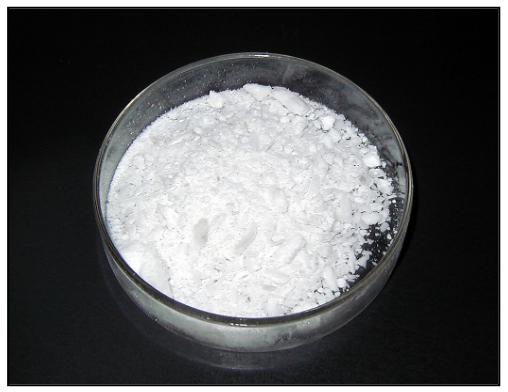
Pic. 2 is pelletized NGH which is burning.
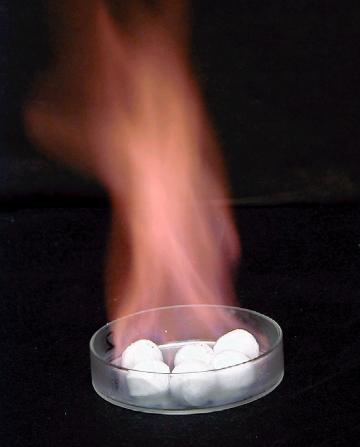
Concept of NGH Transportation
Pic. 3 is a conceptual diagram of the natural gas transportation system presented by MES.

The natural gas exploited in a gas field is transported through pipe lines to the plant and processed into NGH together with the water. The NGH is pelletized with a peletizer, stored in reservoir tanks temporarily, and loaded onto NGH carriers. It is transported to a consuming place by the carriers and unloaded there. Unloaded pellets are temporarily stored in reservoir tanks and re-gasified with a gasifying unit. The gasified natural gas is delivered to places of consumption. After re-gasification of NGH, the residual water is stored in reservoir tanks, loaded onto the carrier, transported to the loading side and used for processing NGH again.
Evaluation of Properties of NGH Pellets
Storage of NGH Pellets
The volume of solid NGH pellets is 0,56 per unit volume of cargo space while that of powdery NGH is 0,4. This means that the storage capacity is increased to 1,4 times by pelletization. In order to further increase the storage capacity, pellets of different particle sizes can be mixed so that the fine particle go into gaps of the larger particle (like so-called close-packed filling). Using such a storage method, the storage capacity of 1,8 times is expectable compared with powdery NGH in the same space. Refer to Pic. 4.
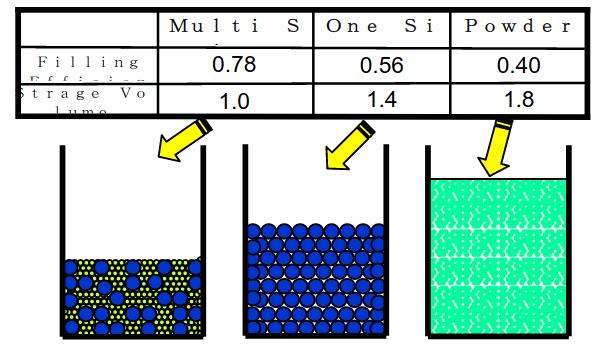
Self Preservation Effect of NGH Pellets
In transporting of NGH, essentials are storage temperature and pressure. NGH dissociation temperature is presented by the intersecting point of the 3-phase temperature/pressure equilibrium diagram. In case of methane hydrate, that is about -80 degree C at atmospheric pressure. Refer to Pic. 5.
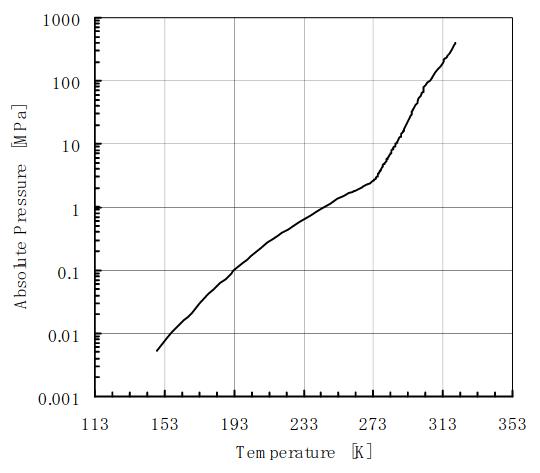
The self-preservation effect of gas hydrate, which suggests possibility of storing gas hydrate at normal pressure, was published in 1991 by Yakushev and Isotomin.
Ebinuma et al. showed that, when gas hydrate is dispersed in ice at a temperature below zero, dissociation of the gas hydrate is restricted even at the atmospheric pressure unstable thermodynamically.
The principal of the self-preservation is considered such that, when gas hydrate consisting of gas and water is taken into the normal environment, dissociation starts from its surface and the dissolved water covers the surface of the hydrate particle units with ice film due to the absorb-heat at dissolving, consequently the gas hydrate surrounded with film is prevented from further dissociation.
Through series of our experiment, it was found that powdery NGH was much improved in self-preservation effect by being made into pellet.
To evaluate the self-preservation effect of powdery NGH and pelletized NGH, dissociation rate was checked. The samples were observed in a vessel of 11 ml with a pin hole (0,8 mm Dia.) on its top to prevent from rise of pressure. The change of weight of the specimen was measured for 2 weeks under the temperature of -20 degree C. As shown in the Pic. 6, it is clear that the self- preservation effect is remarkably improved in the pellet NGH. The volume of dissociating gas of NGH pellets at -20 degree C is as low as 0,25 weight % per day or below of original gas weight.
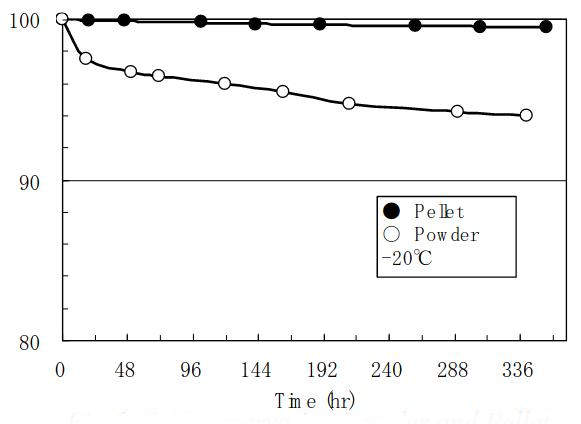
It was also examined at which temperature the self- preservation effect of NGH pellets was most remarkable. For this purpose, the changes of dissociation rate of NGH pellets, which we produced, at temperature between -120 degree C and -5 degree C were measured systematically. Pic. 7 and Pic. 8 show the results.
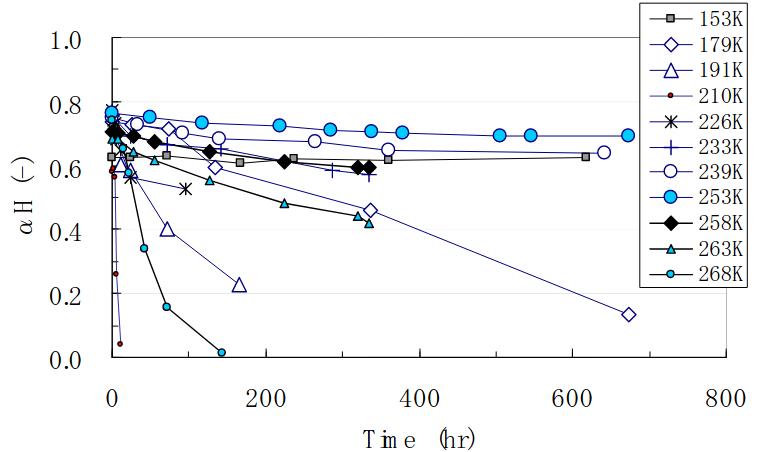
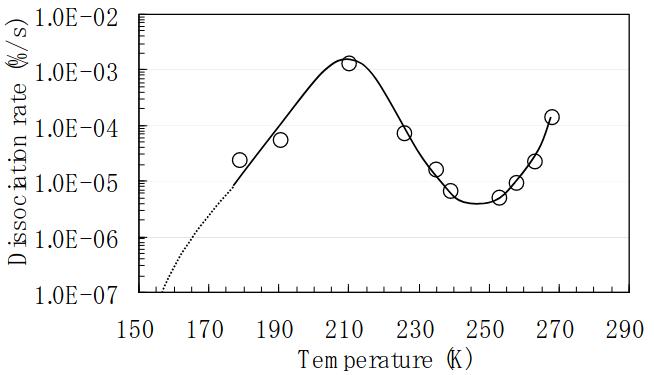
As shown in the figures, it was confirmed that the most stable point was very sharp peak of -20 degree C and even -25 degree C or -15 degree C dissociation rate goes up remarkably.
NGH Process Development Plant
Mitsui Engineering & Shipbuilding Co., Ltd. (MES) has constructed and is now operating a process development plant to produce 600 kg methane hydrate per day under the financial support by Japanese governmental body of the New Energy Development Organization (NEDO) and Japan Oil, Gas and Metals National Corporation (JOGMEC).
The plant was made to verify to produce high-purity methane hydrate and mixed gas hydrate from methane gas and simulated natural gas with the contact-reaction method. The processes is equipped with hydration, dehydration, cooling, pelletizing and re-gasification device which can be achieved at high speed.
Pic. 9 shows overview of the plant.
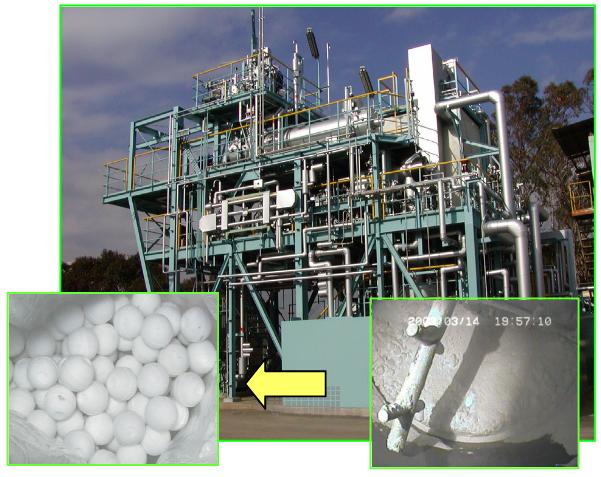
NGH Pellet Carrier
Properties of Pellet Cargo
NGH pellets may be regarded as a cool solid bulk cargo. Based on the study, the properties of NGH pellets cargo to be transported are estimated. The specific gravity is about 0,81 and filling ratio in cargo hold about 0,78. And the bulk density is about 0,63. These figures may be adjusted according to future study.
MES has found that the most stable point of NGH pellet is at -20 degree C under atmospheric pressure. In other words holds of NGH carriers are kept with temperature at -20 degree C. Even at this condition the dissociation of NGH pellets occurs. The rate of the dissociation is expected as 0,05 weight % of gas weight contained in NGH pellets per day.
Comparison NGH/LNG Carrier
NGH Pellets bulk cargo obtains about 80-90 kg natural gas per 1 m3, while LNG contains about 450 kg of gas in 1 m3. This means NGH carriers have to transport about 5 times cargo in volume for same natural gas. The other hand, LNG carrier controls cargo temperature at -162 degree C but NGH carrier does at much milder temperature of -20 degree C. Pic. 10 shows comparison of NGH/LNG carrier.
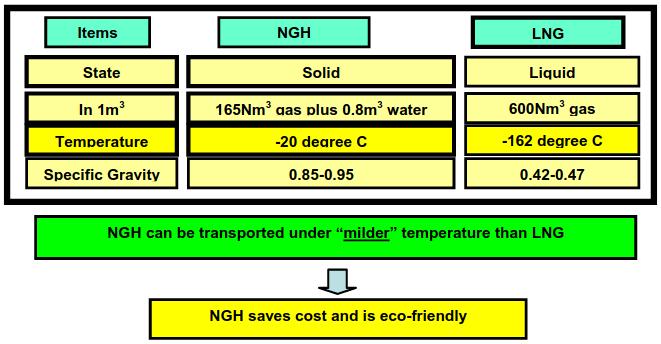
Outline of NGH Carrier
MES has studied design of the NGH carrier for three years under financial support by the Japan Railway Construction, Transport and Technology Agency (JRTT).
Principal idea of NGH pellets carrier is a cool bulk carrier taking the safety philosophy Flammability, Explosion and other Hazards of Liquefied Gasagainst flammable gas into the design. MES carried out conceptual design based on following key words:
- Economical;
- Safe handling;
- Easy cargo handling;
- Prevention of methane gas emission.
Economical is essence for Basic Info about Liquefied Petroleum Gas Transportation on the LPG tankersenergy transportation. In compare with LNG carrier, NGH carrier has disadvantage in cargo volume to be transport.
Transforming NGH powder into the pellets is one of the ways to condense the cargo volume. The pellets have advantages not only for improvement of self preservation effect but also for economics of transportation. NGH pellets also give good effect to cargo safety because evolved gas can be reduced by formed into pellets. Further pellets are good at cargo handling than NGH powder.
Prevention of methane gas emission is very important for NGH carrier. Back ground of development of natural gas transportation in the form of NGH is to prevent the green house effect of the earth. Natural gas (methane gas) is harmful gas for the green house effect, which is worse as 21 times effect as CO2 gas. Therefore NGH cargo should be transported with enclosed system from atmosphere including loading and unloading stages.
Cargo Hold
The cargo holds of NGH carrier are insulated from inside hull to keep the cargo at -20 degree C. There are two kind of heat acting on NGH cargo in the hold. One is heat transmitted through hull from environment. Second is absorbent heat when NGH dissociates. Design of cargo hold should take consideration of these kinds of heat Pic. 11 shows computer output of heat calculation for cargo inside of hold.

Pic. 12 shows insulation idea of the hold.
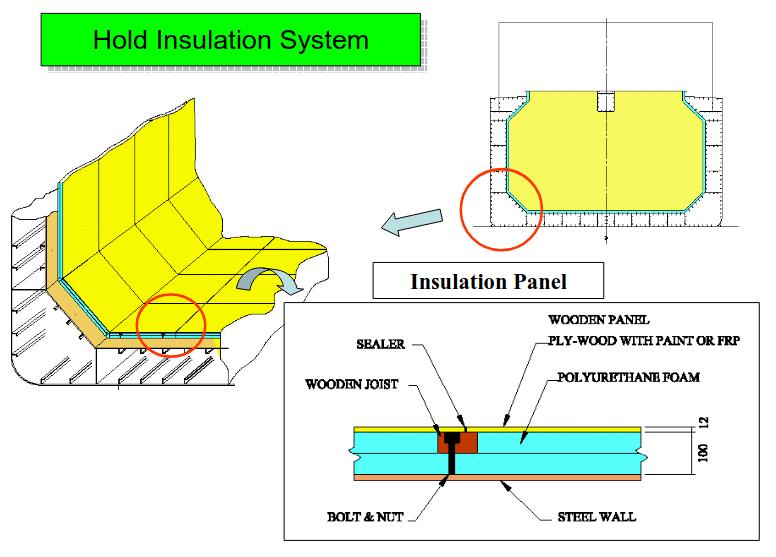
Evolved Gas
NGH pellet is stored and transported at the condition of – 20 degree C under atmospheric pressure. NGH pellets still dissociate even at that condition. The rate of the dissociation is estimated about 0,05 weight % of natural gas contained in NGH pellets cargo per day. This quantity is not enough for propulsion fuel and too much for generator fuel. Two ways of application are considered. One is to use at first as generator fuel and the balance as backing up of propulsion through a shaft generator. Other is to compress and store in a pressure tank up to discharging it to a shore on arrival at unloading port.
Loading and Unloading
Loading and unloading of NGH pellet is the most sensitive matter for NGH carriers. Following key factors should be considered for design of NGH carriers.
- Gas emission free when loading and unloading.
- Safety measures against flammable gas.
- Speedy unloading of bulk NGH pellets.
Four unloading methods are studied. Those are mechanical way, pneumatic unload, unloading in form of slurry and discharge natural gas after re-gasification in a vessel.
The slurry method is attractive but can not find out the suitable liquid medium which does not freeze at -20 degree C. Mixing pellets into medium and separation from medium are also the matter to be checked. In case of the pneumatic method, huge volume of inert gas or methane gas is required.
In conceptual design, the mechanical system was adopted. Pic. 13 and Pic. 14 show the concept of NGH carrier with mechanical unloading system. The vessel in Pic. 13 is one with vertical and horizontal conveyor system, which is applied when the NGH pellets cargo have enough fluidity.
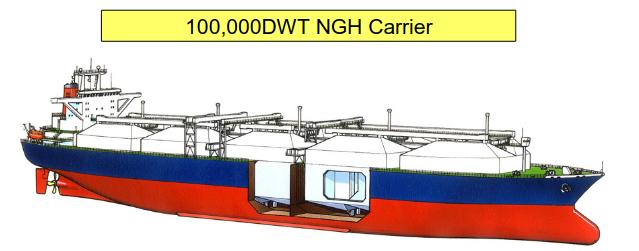
Length, p. p.: 275,0 m
Breadth, mld.: 46,0 m
Depth, mld.: 25,5 m
Draft, design: 14,0 m
Cargo capacity: abt. 160 000 m3
Speed, service: abt. 17,0 kt
In case that the fluidity of pellet cargo is not enough, other mechanical appliance of re-claimer system is studied. The vessel in Pic. 14 has a totally enclosed house on deck and two re-claimers work in it.
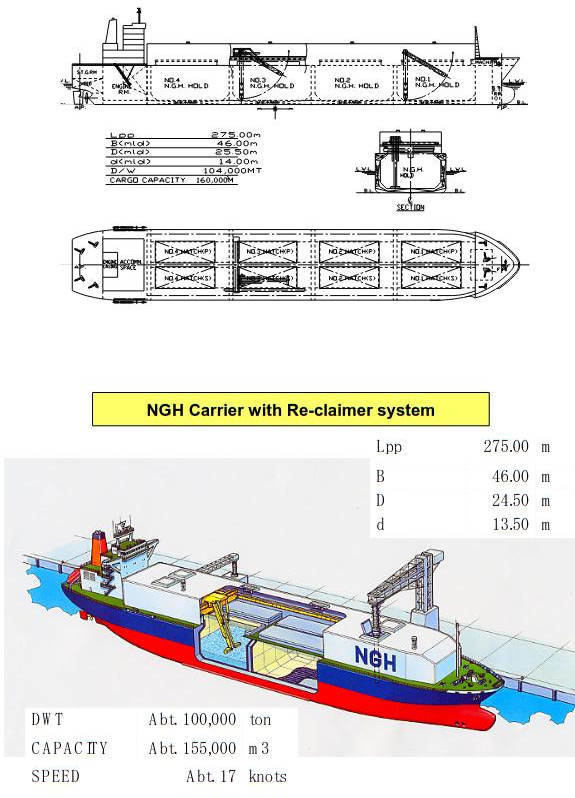
Adoption of the mechanical unloading system requires more study for prevention of gas leak of the system and safety measure of anti-explosion. There is another idea of cargo gas discharge after re-gasification of NGH in the carrier to a shore. In this case NGH pellets cargo is made re-gasification with sea water and the carrier works as a storage tank. Pic. 15 shows concept of such system.
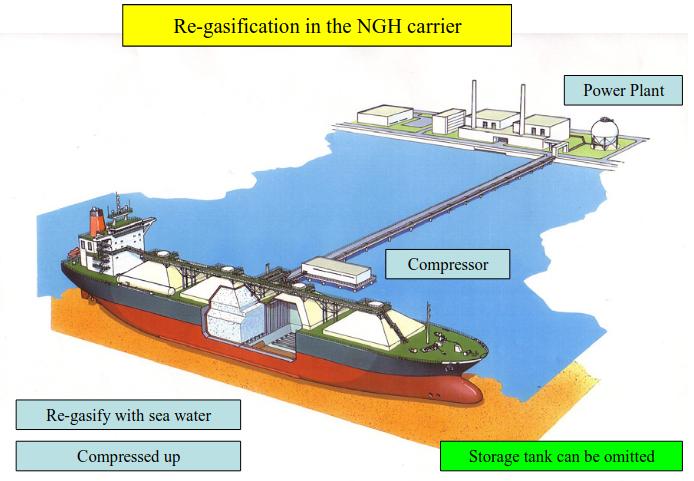
Conclusion
MES has promoted industrialization of NGH pellets transportation system covering production, pelletizing, storage, sea transportation and re-gasification of NGH. Through the study and concept designs of NGH carrier, we have found that natural gas transport in form of NGH pellets had economical advantage in gas transportation with distance less than 3 000 nautical miles compared with LNG system. The distance of 3 000 nautical miles has significant meaning for natural gas trade. Pic. 16 and Pic. 17 show trade area of 3 000 nautical miles.

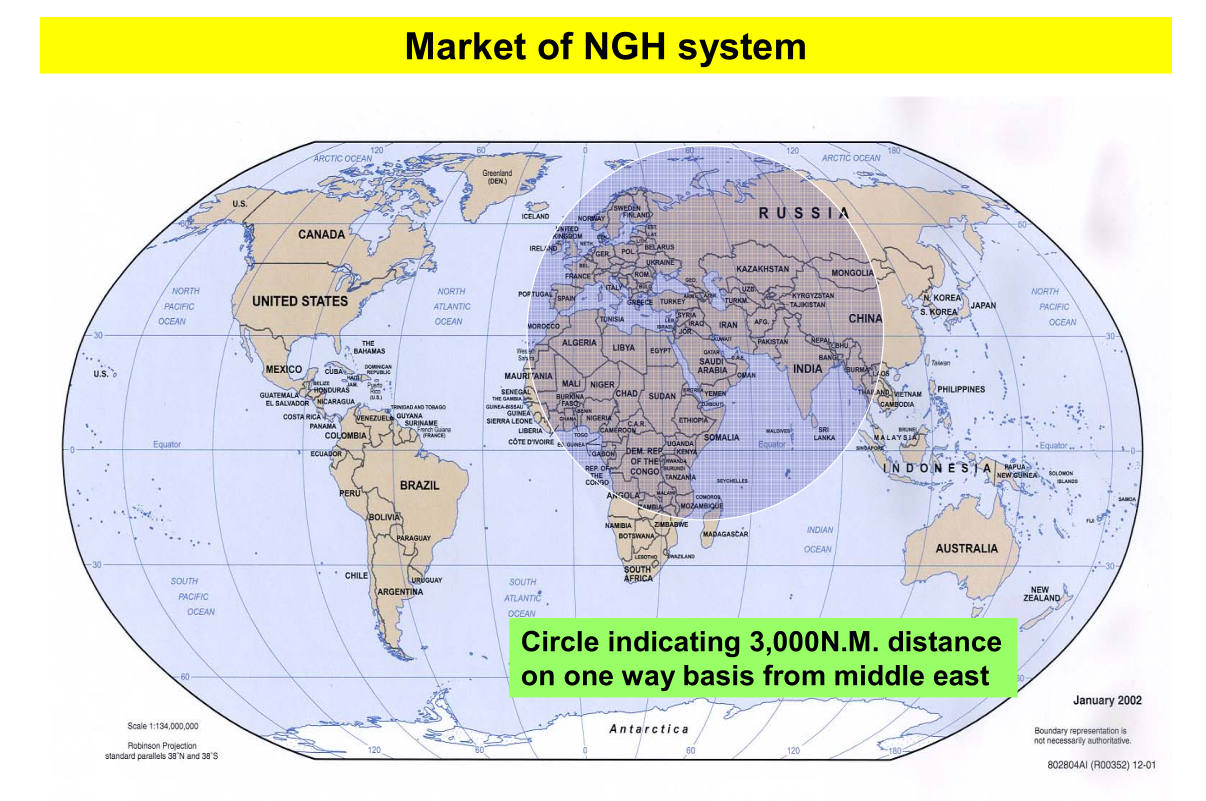
MES will speed up the development to materialise the NGH pellets system including further study of NGH carrier.
